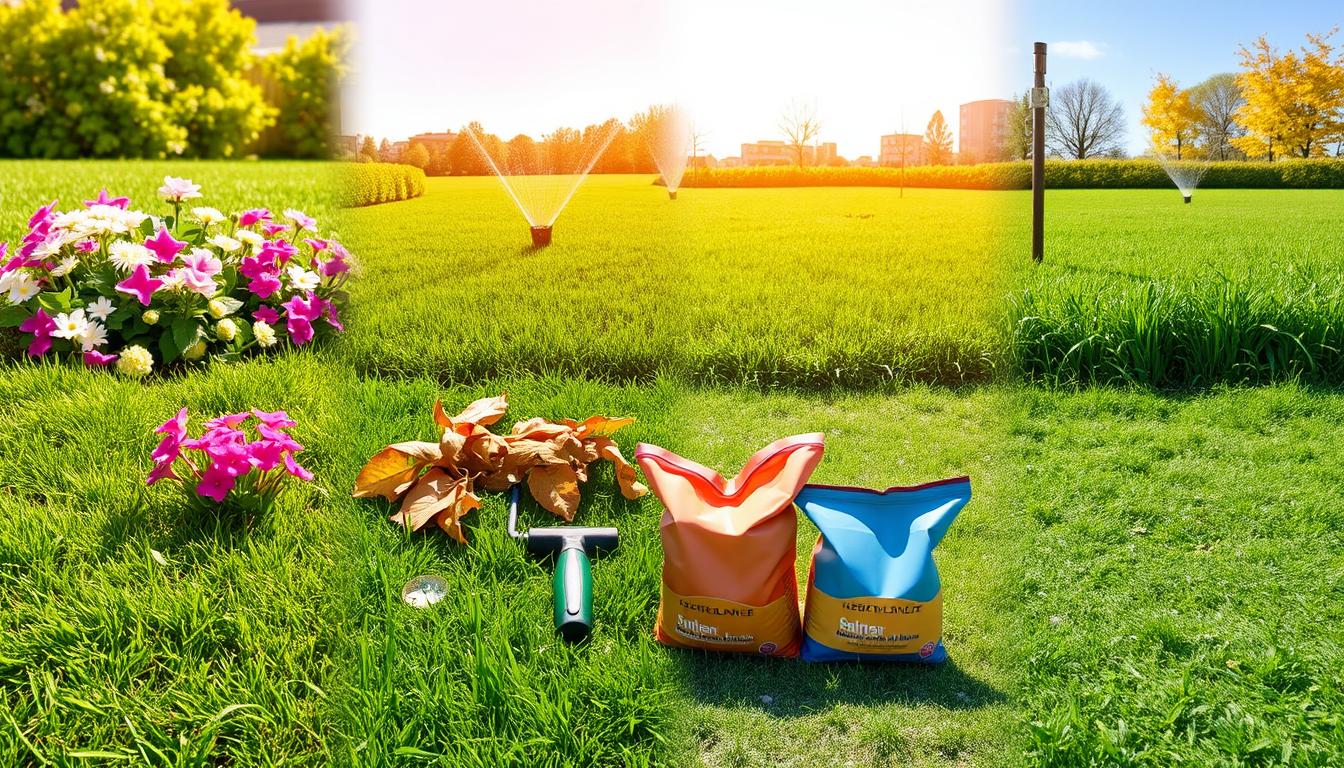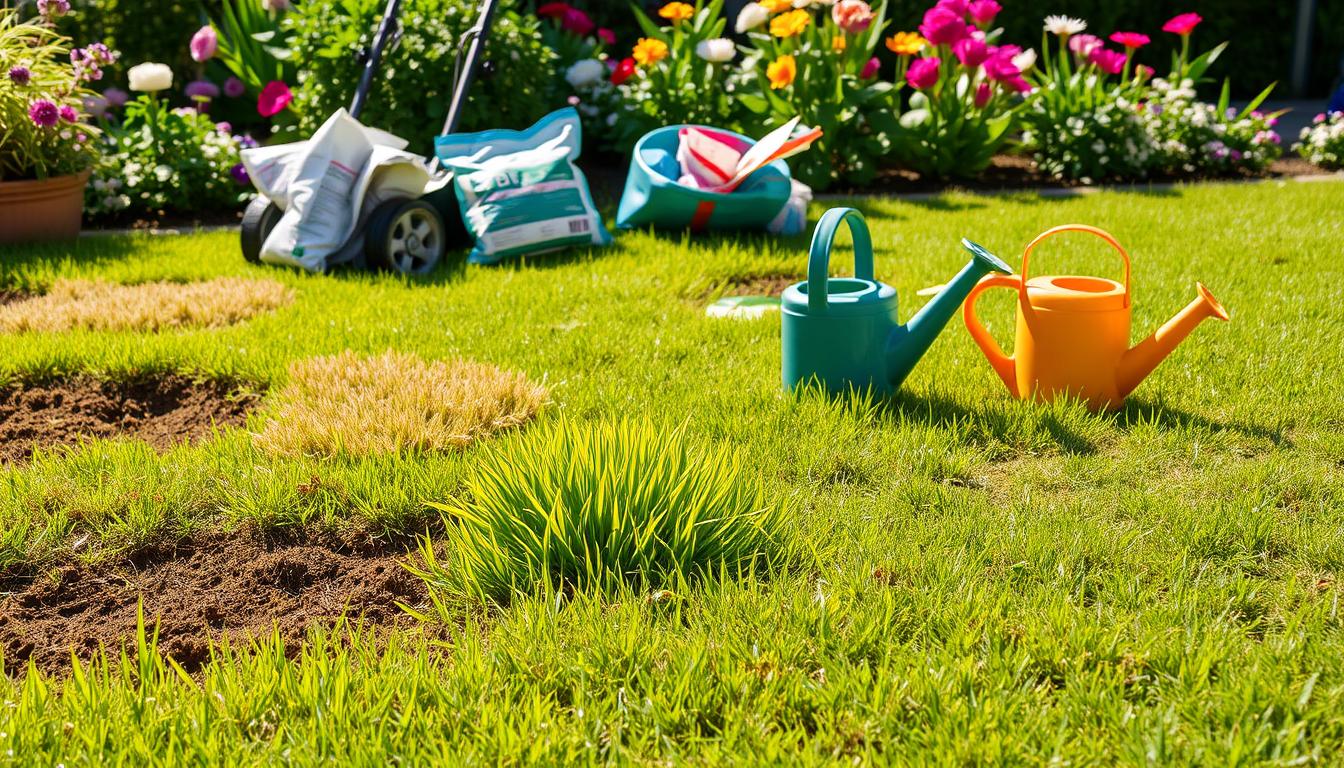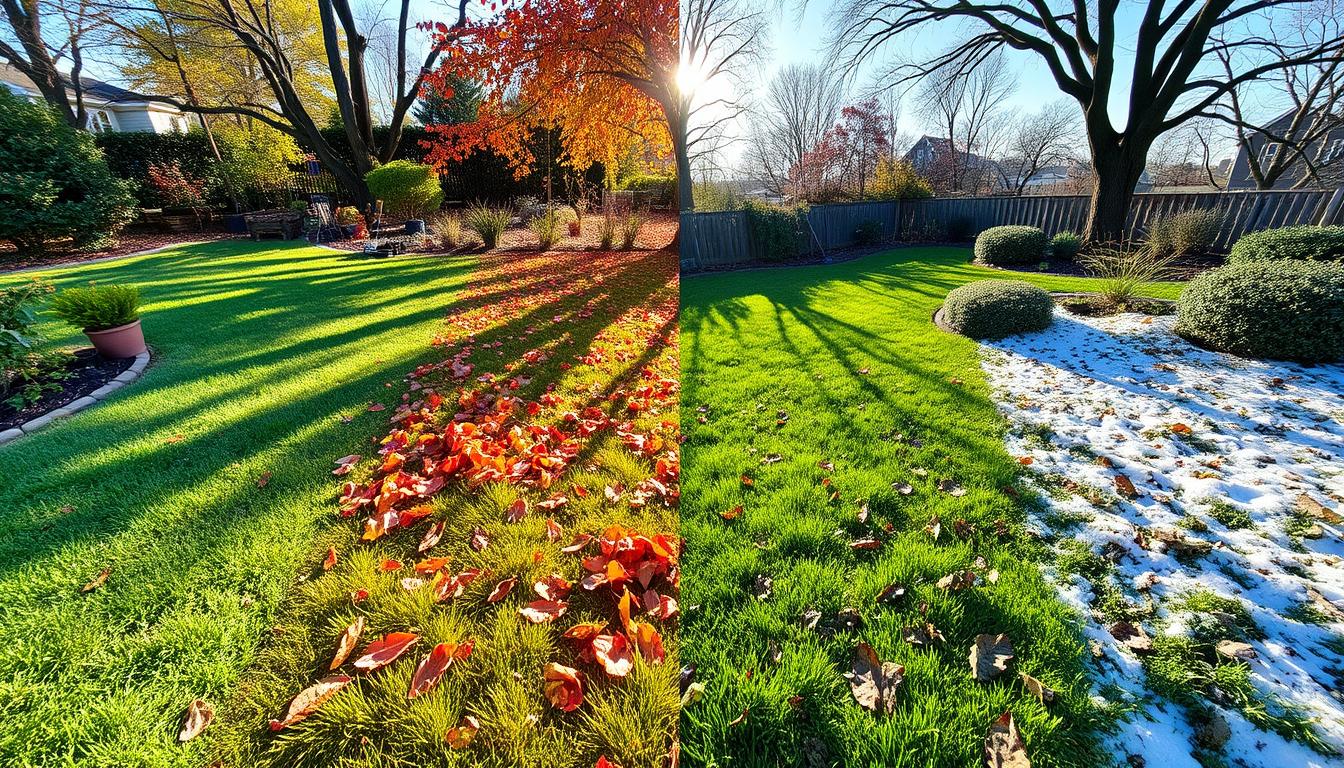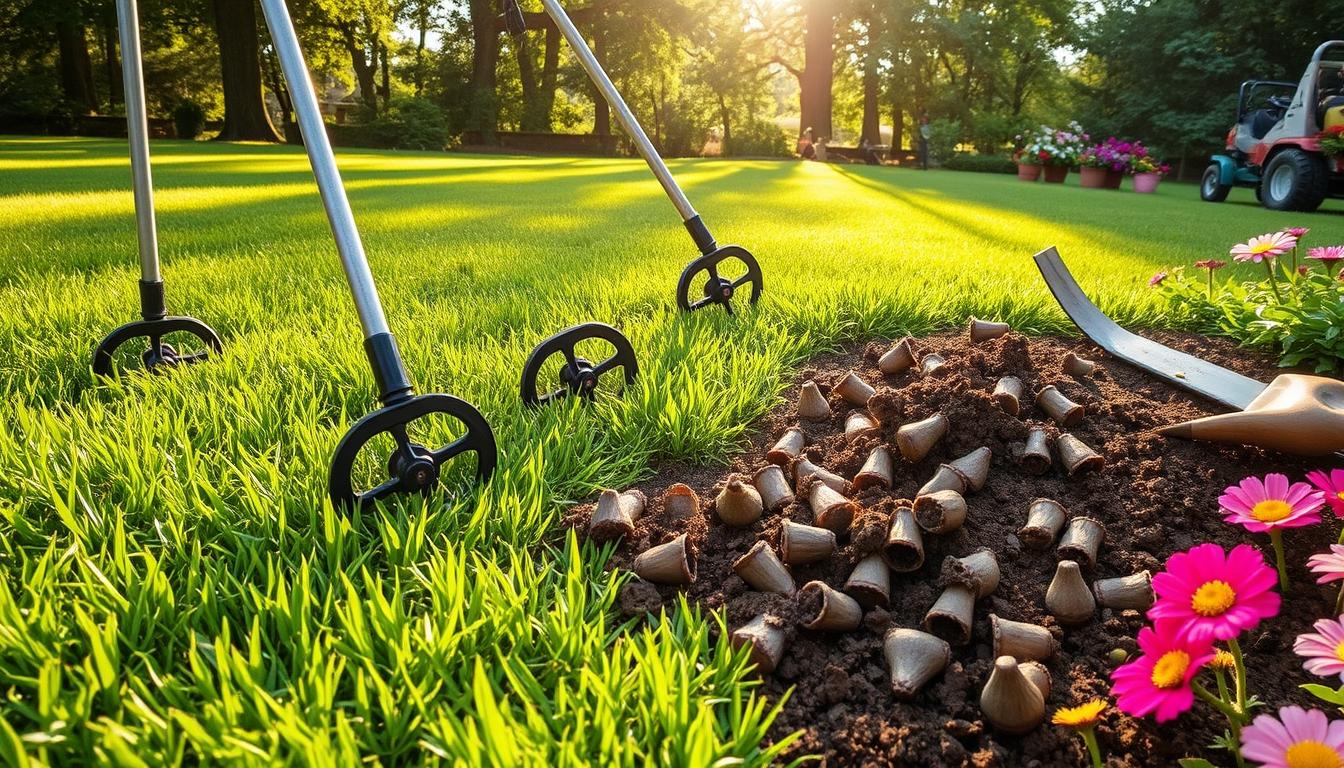Imagine stepping onto your lawn and feeling the crunch of dried grass. It’s not just annoying; it’s a sign of a bigger problem. Many homeowners face this issue, realizing their lawn is suffering from compaction. They wonder about the science of aerating and how it can make their lawn lush.
Lawn care doesn’t have to be a mystery. Knowing when and how to aerate can make your grass healthier. As we dive into lawn aeration, you’ll see its many benefits. Blackened patches and spots where growth is lacking are signs your lawn needs attention.
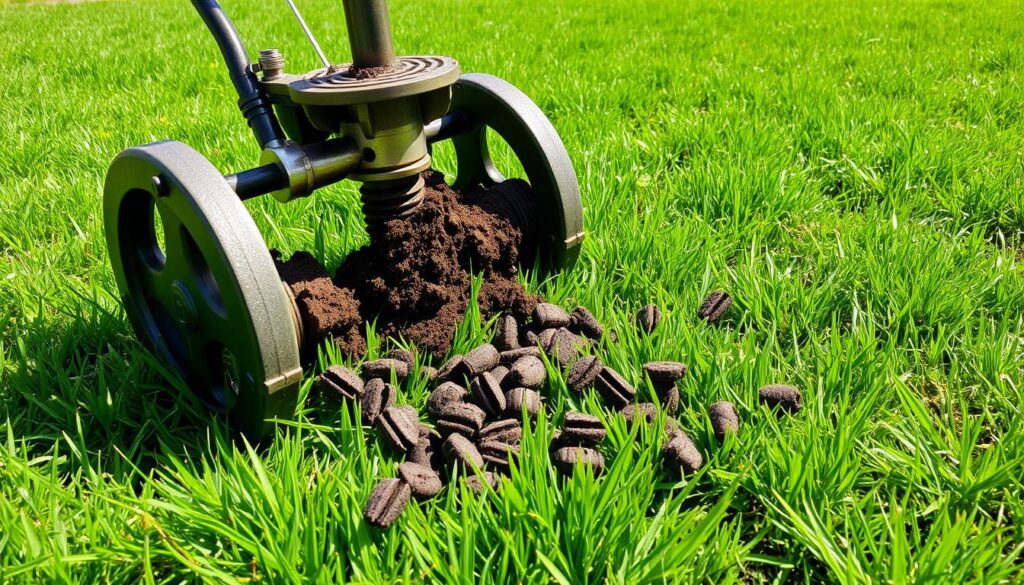
We’ll look at the best times and methods for aerating. You’ll learn how to create a vibrant, thriving lawn. From different techniques to solving common lawn problems, you’ll get all the info you need.
Key Takeaways
- A compacted soil layer of just 1/4 to 1/2 inches can greatly affect lawn health.
- Heavy clay soil areas may benefit from annual aeration to prevent thinning.
- Cool-season grasses should be aerated in early fall or spring, while warm-season grasses favor late spring or early summer.
- Core aerators are generally more effective than spike aerators.
- A simple screwdriver test can determine if aeration is required.
- Aerating while grass is actively growing promotes quick recovery.
- Following aeration with overseeding and fertilizing can enhance growth and vitality.
Understanding the Importance of Lawn Aeration
Lawn aeration is key to keeping your grass healthy. It’s important to know what aeration is. This process makes the soil better for air, water, and nutrients to get through. It helps solve many lawn problems.
What is Aeration?
Aeration makes small holes in the soil. This lets air, water, and nutrients reach the roots better. It’s essential for strong grass growth.
Benefits of Lawn Aeration
Aeration has many benefits. It helps in several ways:
- It relieves soil compaction, making roots healthier.
- It improves water absorption and drainage.
- It helps grass absorb nutrients, making it look lush and green.
- It reduces stress on the lawn, especially in busy areas.
Knowing why lawn aeration is important is just the start. These benefits make your lawn stronger and more beautiful.
Common Lawn Problems Addressed by Aeration
Many people struggle with compacted soil, thatch, and poor drainage. Aeration fixes these issues by:
- Breaking up compacted soil, helping roots grow.
- Reducing thatch, which blocks nutrients and water.
- Improving drainage by creating water channels.
Aeration tackles these common problems. It makes your lawn healthier and more attractive.
When to Aerate Your Lawn
Knowing when to aerate your lawn is key to keeping it healthy and looking good. Different grass types need aeration at different times. Spotting when your lawn needs aeration can help it last longer and look better.
Optimal Timing for Cool-Season Grasses
Cool-season grasses, like Kentucky bluegrass, need aeration in two main times. Early spring, from early April to late May, and late summer to early fall, from late August to late October, are the best times. Aerating then helps the grass grow strong and fast.
Best Practices for Warm-Season Grasses
Warm-season grasses, like zoysia and buffalograss, need a different schedule. Aerate them when they’re actively growing, from late May to late August. This helps them recover well and stay healthy.
Signs Indicating Your Lawn Needs Aeration
Watching for signs your lawn needs aeration can stop bigger problems. Look out for:
- Soil feeling hard to the touch
- Water pooling on the surface instead of soaking in
- Grass showing stress, like browning or thinning
- Visible thatch buildup blocking air and water
Also, try the “screwdriver test.” If a screwdriver has trouble going into the soil, it means the soil is compacted and needs aeration.
| Grass Type | Optimal Aeration Period | Signs of Compaction |
|---|---|---|
| Cool-Season Grasses | Early Spring / Late Summer | Hard soil, water pooling |
| Warm-Season Grasses | Late Spring to Early Fall | Browning, thinning grass |
The Science of Aerating: When and How to Aerate Your Lawn
Aeration is key to a healthy lawn, improving soil and grass growth. Knowing when and how to aerate keeps your lawn green and lush. This part explains the process and how often to do it for different lawns.
The Aeration Process Explained
The main aeration method is core aeration, which takes out small soil plugs. These plugs, about ½ to ¾ inch wide, make holes for better water, nutrient, and air reach. Lawns should have 20 to 40 holes per square foot for best results.
This method is great for lawns in clay soil or with lots of foot or pet traffic. It helps reduce soil compaction.
Frequency of Aeration: How Often Should You Aerate?
How often to aerate depends on soil type, lawn use, and weather. Lawns in heavy clay soil or with lots of traffic might need aeration twice a year. Lawns with less traffic and well-drained soil might only need it once a year.
Some lawns might not need it as often. It’s important to check your lawn’s specific needs. Aerating at the right time, like in September or April, works best. After aerating, adding a thin layer of compost can improve soil quality even more.
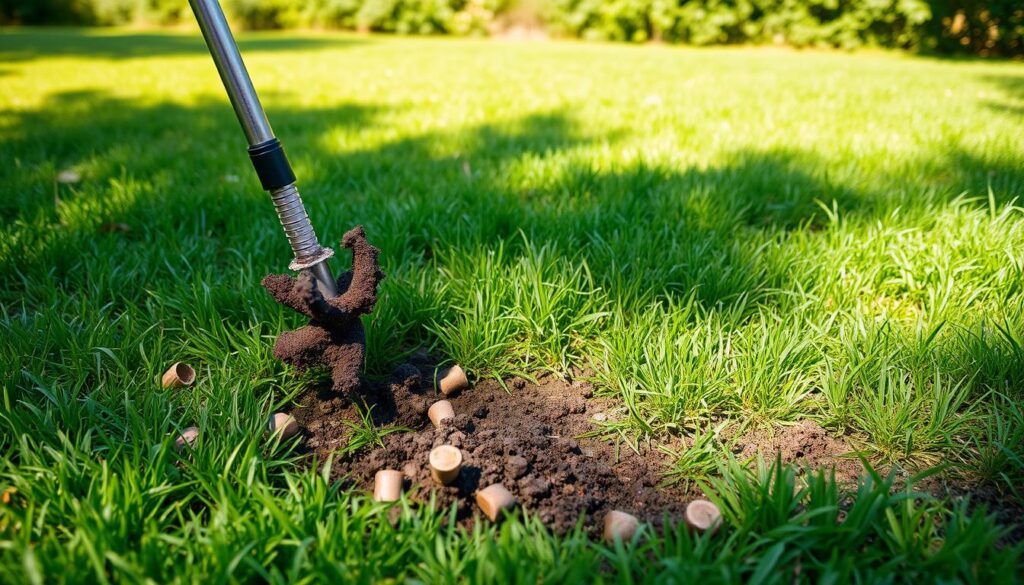
| Type of Lawn | Recommended Aeration Frequency | Ideal Aeration Times |
|---|---|---|
| Heavy Traffic Lawns (Clay) | Twice a year | April, September |
| Low Traffic Lawns (Well-drained) | Once a year | April, September |
| Less Compacted Lawns | Every 2-3 years | As needed |
Types of Aerating Tools and Techniques
Knowing about different aerating tools and methods is key for a healthy lawn. Each technique has its own benefits and works best for specific lawn types. We’ll look at core aeration vs. spike aeration, manual and mechanical tools, and DIY tips for homeowners.
Core Aeration vs. Spike Aeration
Core aeration and spike aeration are two main ways to improve lawn health. Core aeration removes soil plugs, letting air, water, and nutrients reach the roots better. It’s great for lawns with a lot of compaction.
Spike aeration just pokes holes in the soil without removing it. This can sometimes make the soil more compacted. So, core aeration is usually the better choice for the best results.
Manual and Mechanical Aerating Equipment
Homeowners have many lawn aeration tools to pick from. These include:
- Manual Aerators: Good for small lawns, they need you to physically make holes in the soil.
- Push Aerators: Great for medium-sized lawns, they use tines to remove soil as you push them.
- Tow-Behind Aerators: Best for big areas, they can be pulled by a mower or vehicle, making the job easier.
For an alternative, you can use soil conditioners. But they might not work as well or fast as core aeration. Choosing the right tool is important for good results.
DIY Aerating Tips for Homeowners
Using DIY aerating tips can help improve your lawn care. Here are some helpful tips:
- Make sure the lawn is moist before aerating. This helps the tools go into the soil without getting stuck.
- Focus on areas that are really compacted. You might need to go over them a few times to get them right.
- Let the soil plugs stay on the lawn. They will break down and give nutrients back to the grass.
- Think about fertilizing and reseeding right after aerating. This helps the lawn soak up nutrients better.
- Watch out for weed seeds that come up during aeration. Use the right herbicides for your grass type.
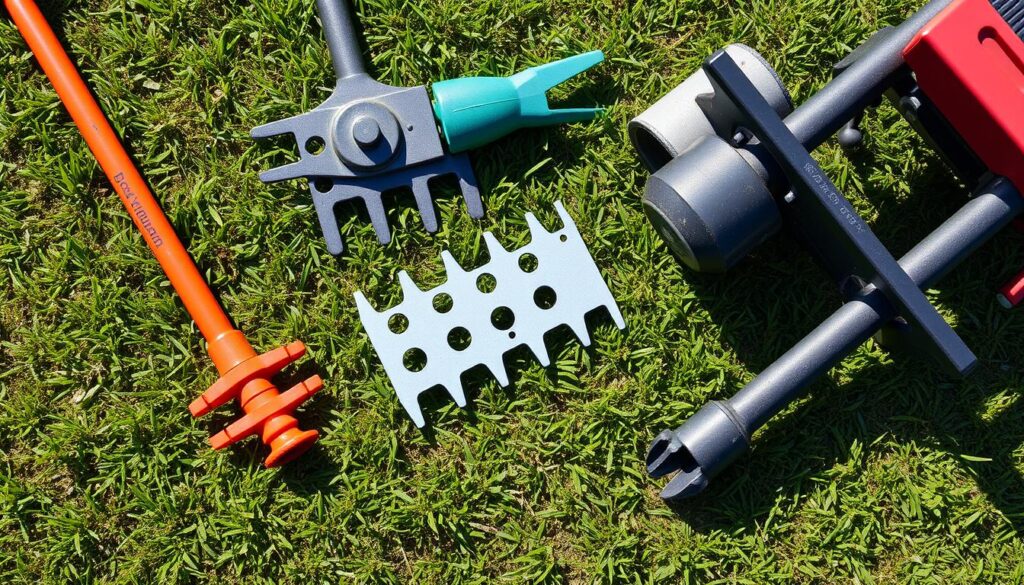
By learning about different aerating tools and methods, homeowners can choose the best for their lawn. This helps keep the grass healthy and the ecosystem thriving.
| Technique | Benefits | Best For |
|---|---|---|
| Core Aeration | Improves air circulation, water penetration, and nutrient absorption | Compacted lawns needing significant relief |
| Spike Aeration | Punctures soil but can worsen compaction | Lighter, less compacted areas |
| Manual Aerators | Cost-effective for small areas | Small lawns or specific problem spots |
| Push Aerators | More efficient than manual, suitable for mid-sized lawns | Medium lawns |
| Tow-Behind Aerators | Highly efficient for large lawns | Large areas with significant aeration needs |
Conclusion
Adding aeration to your lawn care aeration guide is key for a lush, green yard. It boosts root growth and soil structure. This leads to many benefits, like better soil and healthier grass.
The act of pulling out soil plugs gives roots room to grow. This makes your lawn stronger against drought and nutrient shortages.
Timing is everything when aerating. Cool-season grasses do best in early fall or spring. Warm-season grasses need late spring or early summer treatments. Following these lawn maintenance tips will make your lawn stronger.
Many homeowners aerate once a year. Some do it twice, especially in busy areas.
Remember, aeration and overseeding are a winning combo. They make your turf denser and help it recover faster. By using these methods, your lawn will stay vibrant and healthy. This shows the big benefits of good aeration for healthy grass growth.
FAQ
What is lawn aeration?
Lawn aeration makes small holes in the soil. This helps air, nutrients, and water reach the roots. It encourages deeper and healthier root growth.
Why is aeration important for my lawn?
Aeration helps solve soil compaction. It also improves water and nutrient absorption. This leads to healthier grass and a greener yard.
When should I aerate my lawn?
For cool-season grasses, aerate in early fall or spring. Warm-season grasses do best in late spring or early summer.
How often should I aerate my lawn?
Aeration frequency depends on soil type and usage. Heavily used lawns or clay soils need it yearly. Less used lawns might need it every two years.
What signs indicate that my lawn needs aeration?
Hard soil, water pooling, stressed grass, and thatch buildup are signs. A screwdriver test can also check soil resistance.
What is the difference between core aeration and spike aeration?
Core aeration removes soil plugs for better air and nutrient access. Spike aeration just makes holes without removing soil, which can cause compaction.
What tools can I use for aerating my lawn?
You can use manual or mechanical aerators. Choose based on your lawn’s needs. Tools are available for rent at garden centers.
Can I aerate my lawn myself?
Yes, you can aerate your lawn. Do it when the soil is moist. Focus on the most compacted areas for best results.
After aerating, what should I do with the soil plugs?
Leave the soil plugs on the lawn. They will break down and return nutrients, improving lawn health.
Source Links
- Why, When and How to Aerate Your Lawn
- The Importance of Aerating Your Lawn – Earth Science
- The Science Behind Lawn Aeration & How It Benefits Soil
- Aeration: Why, How & When to Aerate Your Lawn
- Understanding the Importance of Lawn Aeration for Summer Growth
- Getting Your Lawn Ready for Summer – Aeration | UNL Water
- Best time to aerate?
- How Often Should I Aerate My Lawn | Davey Tree
- Core Aeration of Lawns
- The Science Behind Aerating Your Lawn – Cleanr Property Maintenance
- Aerate Lawns: An Aerator How To Guide
- Unlocking Soil Potential: How Core Aeration Breathes Life into Compact Soil
- The Essential Guide to Lawn Aeration: Ultimate Tips for Aerating Your Yard | Landscaping Guide
- There is no debate, you really do need to aerate
- Aeration and Overseeding: The Ultimate Guide

